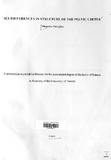| dc.contributor.author | Magoma, Georgina | |
| dc.date.accessioned | 2016-05-25T15:59:35Z | |
| dc.date.available | 2016-05-25T15:59:35Z | |
| dc.date.issued | 2010 | |
| dc.identifier.uri | http://hdl.handle.net/11295/95938 | |
| dc.description.abstract | Background: Structure of the pelvic ureter plays a key role in the mechanism for prevention of vesico-ureteric reflux. Alterations of morphometric and histomorphological features such as length, obliquity and orientation of muscle fibers have been implicated in etiology of reflux. The oblique course and length of the intra-vesical ureter make up the passive mechanism while contraction of the distal longitudinal muscle layer contributes to the active component. A length: luminal diameter ratio of 5:1 is considered adequate to prevent reflux. Vesico-ureteric reflux is common in females than in males. The basis for this difference has not been elucidated. Anatomical sex differences in the pelvic ureter may partially explain the female preponderance to vesico-ureteric reflux. There is, however, scarcity of data on these differences in the organization of the pelvic ureter.
Objective: To determine sex differences in the structure of the pelvic ureter Study design: A descriptive cross - sectional study.
Materials and Methods: A total of 100 ureters from adults (54 male and 46 female) at the Department of Human Anatomy University of Nairobi were studied. Eighty eight (48 male and 40 female) of these were cadaveric. These were used for morphometry. Twelve (6 male and 6 female), harvested during autopsy were used for histomorphology. Harvesting was performed through a midline anterior abdominal wall incision and cranial reflection of abdominal viscera. Length and angle at which intra-vesical ureter lies to the bladder was measured in millimeters and degrees respectively. Five millimeter sections were taken from juxta-vesical, mid and distal intra-vesical segments. These were fixed in formal saline solution and processed routinely for paraffin embedding. Seven micrometer sections were stained with Masson’s Trichrome to demonstrate orientation of smooth muscle cells and collagen fibers.
Morphometric data were analyzed using SPSS (Version 16.0, Chicago Illinois) for means and standard deviations. Sex differences in morphometry were determined using the Student’s t test. A value of p<0.05 was considered statistically significant. Pearson’s correlation test was used to test for correlation between length and angle. A Two-tailed test was used to test for significance of the correlation co-efficient. A p - value < 0.01 was considered significant.
Results: The mean intra-vesical length of pelvic ureter in males was 18.69 mm compared to 14.81mm in females (p - value of <0.000). The angle at which ureters lay to the bladder was 26.75° in males and in females 29.10° (p - value of 0.018). In all sections, the ureter displayed a mucosa,
muscularis and adventitia. In males, the muscularis of juxta-vesical ureter displayed three layers
namely an inner longitudinal, intermediate circular and an outer longitudinal. In females on the other hand, two layers namely an inner longitudinal and outer circular were observed. In the mid intravesical
segment, the muscularis in males displayed two layers: an inner longitudinal and outer circular while in females only the longitudinal layer was present.
Conclusion: The pelvic ureter displays sex differences in structure. Its intra-vesical segment is longer and enters the bladder at a more acute angle in males than in females. In the males, the muscularis in the juxta-vesical and mid intra-vesical possess an additional longitudinal and circular layer respectively. These structural differences probably underlie the higher female: male predisposition to vesico-ureteric reflux. | en_US |
| dc.language.iso | en | en_US |
| dc.publisher | University of Nairobi | en_US |
| dc.rights | Attribution-NonCommercial-NoDerivs 3.0 United States | * |
| dc.rights.uri | http://creativecommons.org/licenses/by-nc-nd/3.0/us/ | * |
| dc.title | Sex Differences In Structure Of The Pelvic Ureter | en_US |
| dc.type | Thesis | en_US |
| dc.description.department | a
Department of Psychiatry, University of Nairobi, ; bDepartment of Mental Health, School of Medicine,
Moi University, Eldoret, Kenya | |



